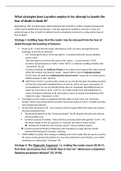What strategies does Lucretius employ in his attempt to banish the
fear of death in Book III?
Reinhardt (p. 291): the Epicureans realised that the fear of death is a rather complex phenomenon,
which may be divided into several types, “and that arguments suitable to convince us that one
particular type of fear of death is irrational may be completely irrelevant to curing another type of
fear of death.”
Strategy I: Instilling hope that the reader may be released from the fear of
death through the teaching of Epicurus
Proem to III -> hope that the reader, like Epicurus (V.8), can learn, through Epicurean
teachings, to live like an immortal
- the “Graiae gentis decus” (III.3) was able to “o tenebris tantis tam clarum extollere
lumen” (III.1)
- That the reader can achieve the same as this “pater (…) rerum inventor” (III.9).
- Lucretius’ presents Epicurus’ truths “nobis” (III.9), i.e. whoever is willing to feed on his
“aurea dicta” (III.12).
- Lucretius continues the build-up of hope as he conjures the image of the realm towards
which this wisdom may lead the reader: “apparet divum numen sedesque quietae”
(III.18). Here, the gods live undisturbed by natural events “neque ulla /res animi pacem
delibat tempore in ullo” (III.23-4).
NOTE that in book V, Lucretius tells us that we can live like the gods “bounding ourselves
off from the temporally extended desires of mortals, which rest upon a perception of
incompleteness. For we are told that those who are completely self-sufficient have no
desire for any chance at all (V. 1 68-72 ). So in their world, there will probably be no
sense of temporal extension at all, and surely no sense of temporal development with
respect to value.” Nussbaum, p. 216.
This object of man’s hope is juxtaposed with the object of man’s fear, the “Acherusia
templa” (III.25), once presented by Lucretius’ forerunner Ennius (I.120-1), of which Lucretius
now promises the absence.
Section after the proem to III -> the concrete means through which the reader may achieve
the aforementioned cure:
The promised absence of the “Acherusia templa” (III.25) already referred to this disease
and its possible cure,
Lucretius’ purpose of writing: “metus ille foras praeceps Acheruntis agendus” (I.37) -> He
will rid the reader of fear by a process of “claranda” the ways of nature (III.36)
reminiscent of Epicurus who has been said to “clarum extollere lumen”.
Lucretius presents himself as following in the footsteps of a sage who has himself
achieved the final goal of Lucretius’ teaching.
CONCLUSION: Lucretius’ first strategy is instilling trust in the reader that he may be cured by
his verses as they present the wisdom of a man who achieved to cure himself, a cure which
constitutes an undisturbed, “heavenly” life.
Strategy II: The Diagnostic Argument, i.e. making the reader aware (III.46-7),
that their unconscious fear of death does in fact not “ullam/esse voluptatem
liquidam puramque relinquit” (III.39-40).
, Lucretius acknowledges that the fear of death doesn’t seem to trouble most people to such
an extent that it has any negative impact on their lives.
The fear of death comes to the surface “in rebus acerbis” and “in dubiis (…) periclis” (III.53,
56)
The fear of death often looms unconsciously, as the poet expresses at a later point (III.871-
8), where he speaks of a “caecum (…) cordi stimulum” (III.874).
Because people are “vitare Acherusia templa petentes” (III.86), they commit many evils.
This strategy of making the reader aware of their (implicit) fear of death hinges on what
Nussbaum (pp. 195-8) has termed the “diagnostic argument” -> 2 kinds of symptoms, i.e.
behavior which may be accounted for by the fear of death.
(1) outer symptoms (more obvious): the behavioural patterns which constitute religio:
Lucretius stresses the prevalence of these patterns, such as sacrifice, oblation and
superstition, in men who are “foedati crimine turpi” and “omnibus aerumnis adfecti”
(III.49-54).
NOTE Due to the focus on religio in the proem of book I, one might presume
that Lucretius’ work focuses on the eradication of religio, as if this were a
sufficient cure for the fear of death. However, religio derives from the fear of
death, not vice versa: or V.177-78, 988-93. Religio, however, does intensify our
fear for death (V.1233-4), unlike the other behavioural patterns which derive
from it, which explains its prominence in DRN.
Nussbaum, p. 200: at the end of book V, Lucretius argues that “it is men's
perception of their own vulnerability before death, and their perception
that the gods lack their own weakness and fear (mortis timor, V.1180) that
is one of the primary causes of the invention of worship and religious
subservience.”
Although not explicitly linked to fear of death, in light of the fear for the Acherusia
templa mentioned in the previous passage, one can see how one might fear lethal
punishment of the gods (i.e. a fear to die) or punishment in an afterlife (i.e. a fear for
the state of being dead).
(2) inner symptoms (less obvious):
fear of dead -> fear of contemptus and egestas -> ambition and greed -> sinful
behaviour “vulnera vitae” as “avarities et honorum caeca cupido” and all sinful
behaviour which derives from these: “non minimam partem mortis formidine aluntur”
(III.59-4).
III.65-7 “turpis enim ferme contemptus et acris egestas / semota ab dulci vita
stabilique videtur /et quasi iam leti portas cunctarier ante”
Motivation for ambition and greed consist in a desire to rid themselves of
“contemptus” and “egestas”, resulting in vulnera vitae because contemptus and
egestas bring man closer to death, which is their greatest fear.
NOTE that Lucretius does not explain how these bring man closer to death
NEVERTHELESS it is easy to see:
- how contemptus leads to life-threatening conflict
- how egestas leads to life-threatening poverty and/or hunger.
“Ab eodem saepe timore” derive envy and all the evils it produces (III.74-7)
AGAIN Lucretius doesn’t explicitly explain the link between envy and the fear of
death,




